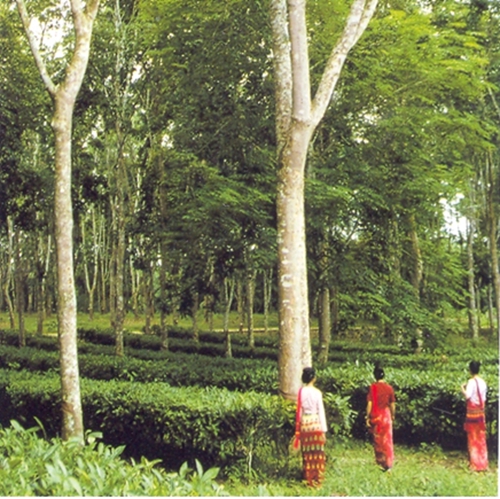
Rubber trees (Hevea brasiliensis) have great economic and social value throughout South-East Asia. The dramatic expansion of rubber plantations has caused many environmental problems, especially hydrological consequences. Although rubber agroforestry systems provide promising solutions, the associations of water use between rubber tree and other intercropped species are poorly documented.
Prof. LIU Wenjie and his team of Xishuangbanna Tropical Botanical Garden (XTBG) selected the three promising agroforestry systems (rubber + tea, rubber + coffee, rubber + cocoa) as observation groups. One rubber monoculture was monitored as a control group. Their aim was to understand how rubber trees benefited from intercropping, especially the water use benefits. They measured leaf δ13C values, shoot water potential and the soil water content (SWC) over the course of the 2013–2014 rainy–dry season cycle to compare the interspecific and intraspecific differences in water use efficiency (WUE), plant ecophysiological functions and moisture conservation abilities at all sites.
The researchers hypothesized that different species in rubber agroforestry systems extracted water from different soil layers to reduce interspecific competition for water and such competition decreased soil water availability, thereby improving the water use efficiency of the rubber trees. They then hypothesized that rubber agroforestry systems had higher ecological resistance (i.e. the capacity to weather a disturbance without loss) and maintain substantially more soil water than rubber monocultures because of the various functions of the intercrops.
They found that rubber trees exhibited a drought-avoidance strategy. The characteristic was reflected by its ability to cope with serious seasonal drought, allowing it to avoid interspecific competition for water. The rubber trees showed wasteful water behavior unless they were intercropped with tea or coffee. However, those intercropped species exhibited drought-tolerance strategies and maintained lower water use efficiencies to strengthen their competitive capacity for surface soil water.
The stable δ13C values of the intercrop leaves indicated that all the agroforestry systems had higher resistance, but tea was the most suitable intercrop in terms of water use because the interspecific competition for water was moderate and the agroforestry system retained much more soil water and improved the water use efficiency of the rubber tree.
The study entitled “Can intercropping with the world's three major beverage plants help improve the water use of rubber trees?” has been published online in Journal of Applied Ecology.

Rubber monoculture (above). Rubber + cocoa, rubber + tea, rubber + coffee agroforestry systems (from L to R, below) (Images by WU Junen)

Rubber + tea agroforestry system at XTBG (Image by WU Junen)

86-10-68597521 (day)
86-10-68597289 (night)

52 Sanlihe Rd., Xicheng District,
Beijing, China (100864)

